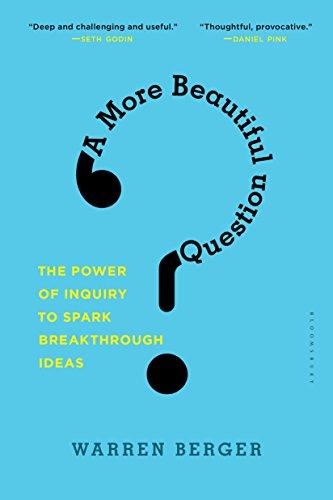A More Beautiful Question Summary
6 min read ⌚
 The Power of Inquiry to Spark Breakthrough Ideas
The Power of Inquiry to Spark Breakthrough Ideas
Why do teachers award children points for giving them the right answer, and not for posing a good question?
What if the point of it all is to ask a more beautiful question?
How should you do that?
Well, let’s just ask Warren Berger.
Who Should Read “A More Beautiful Question”? And Why?
Contrary to what we’ve been taught at school, the learning process is less about memorizing answers and much more about asking questions.
Warren Berger’s book is interested in finding the best ones.
Consequently, it should be an essential read for anyone who wants to become an innovative thinker, since, after all, innovation stems from asking the right questions.
And since innovation is what drives all aspects of society, dear company leaders and entrepreneurs, even dearer scientists and artists – to quote Seth Godin – “what’s keeping you from reading this book right now?”
On a side note: dearest teachers, take copious notes!
 About Warren Berger
About Warren Berger
Warren Berger is an American journalist and a bestselling author, who mainly writes about topics such as creativity and innovation.
Berger has written for a wide variety of publications, among others, the “Harvard Business Review” and “Fast Company.” He was also a longtime contributor at both “The New York Times” and the “Wired” magazine.
He has authored and co-authored 11 books, one of which was the critically acclaimed “Glimmer” which “Business Week” named one of the “Best Innovation & Design Books of 2009.”
A More Beautiful Question” was published in 2014, and recently it was announced that, by the end of the year, it should be joined by a companion piece, “The Book of Beautiful Questions.
Find out more at http://warrenberger.com.
“A More Beautiful Question PDF Summary”
Computers are useless,” said Picasso about half a century ago. “They only give you answers.
The point is – says Warren Berger, borrowing a line from the American poet E. E. Cummings – to find “a more beautiful question.”
That’s what people such as Albert Einstein and Steve Jobs did throughout it certainly did whole humanity a favor:
The author Stuart Firestein, in his fine book ‘Ignorance: How It Drives Science,’ argues that one of the keys to scientific discovery is the willingness of scientists to embrace ignorance – and to use questions as a means of navigating through it to new discoveries.
‘One good question can give rise to several layers of answers, can inspire decades-long searches for solutions, can generate whole new fields of inquiry, and can prompt changes in entrenched thinking,’ Firestein writes. ‘Answers, on the other hand, often end the process.’
So, in a nutshell, humanity profits more from a beautiful question than from a beautiful answer.
Then, why are we living in a world of answers?
In other words, why do the inquiring children in us grow to become the adults afraid of admitting that they don’t know the answer to some question?
You’ve guessed it already:
It’s our schools’ fault!
Preschool children, on average, ask their parents about 100 questions a day,” states Professor Kyung-Hee Kim, “By middle school, they’ve pretty much stopped asking.
And it’s not like they’ve learned all the answers in the meantime!
They’ve just memorized the answers to the questions their bosses want them to know.
In other words, schools were never meant to be outlets of creativity, but merely preparatory courses for a worker’s career.
And even though Google and Wikipedia have rendered memorizing answers practically useless, children are still awarded at our schools for knowing the correct answer to a specific question.
News flash: that’s only a mouse click away!
What’s not – is the beautiful question!
And according to Warren Berger – and a series of interviews with over 100 creative thinkers in science, technology, business, and entertainment – there are three kinds of beautiful questions: why, what-if, and how queries.
Key Lessons from “A More Beautiful Question”
1. The Naivety of a Child: Behind the Zen of a “Why?” and a “Why Not?”
2. Dream Your Way Out of a Problem: Ask Yourself “What If?”
3. Acquire the Perseverance of the Realist: Experiment Through the “How?”
#1. The Naivety of a Child: Behind the Zen of a “Why?” and a “Why Not?”
I know one thing,” claimed Socrates. “And that is – that I know nothing.
Well, contrary to what they’ve taught you at school, it turns out that this is a great way to think about the world – naïvely, with a fresh mind.
Take, for example, Edwin Land, the guy who co-founded the Polaroid Corporation, widely considered the Steve Jobs before Jobs.
On a family vacation in the 1940s, his three-year-old daughter asked him why she couldn’t see the photo just taken by her father.
Edwin Land knew why: the only way you could develop the film was in a dark room. But he also knew that there was another bigger why in his daughter’s question.
And that was the one which – many years later – led to the invention of the Polaroid camera.
The actual Steve Jobs – the Edwin Land after Land – firmly believed in the power of this why-oriented beginner’s mind.
And he was influenced to do so by a 1970 Zen Buddhism classic written by Shunryu Suzuki, “Zen Mind, Beginner’s Mind.”
The mind of the beginner is empty, free of the habits of the expert,” writes Suzuki in the book. Such a mind, he adds, is “open to all possibilities” and can see things as they are.
Knowledge imposes limitations, and that kinda helps when dealing with mechanical tasks.
Want to get creative?
Step back from it by asking why.
And you can even add a great twist: why not?
#2. Dream Your Way Out of a Problem: Ask Yourself “What If?”
Once you’re done with the whys and why nots, it’s time for some dreaming.
In other words, it’s time to ask yourself the what ifs.
Discovery depends on questions such as these.
Because a “what if” question gives you the right mental foundation for a few processes which are essential when it comes to creativity, invention, and imagination: mixing, connecting, and recombining ideas.
We mentioned Einstein and Jobs before.
Do you think that their grand ideas came to them out of the blue?
Of course not!
They just recombined some old ideas in a new way, once they had the step-back luxury of a “why” or a “why not.”
Einstein’s revelation came when he asked himself a fairly childlike question: “What if you could travel on a motorcycle at the speed of light?”
#3. Acquire the Perseverance of the Realist: Experiment Through the “How?”
Of course, once you’ve dealt with the whys and the what ifs – and moved from freshness of naivety to the endlessness of dreaming, it’s time that you transform your knowledge into something much more tangible.
In other words, it’s time for the how.
Of course, this third stage of the “actionable inquiry” process is the most difficult one, since it requires time, knowledge, experimentation, and a lot of endurance.
But, persevere long enough – and the sky is your limit.
Like this summary? We’d like to invite you to download our free 12 min app, for more amazing summaries and audiobooks.
“A More Beautiful Question Quotes”
Don’t just teach your children to read. Teach them to question what they read. Teach them to question everything. Share on X
The main premise of appreciative inquiry is that positive questions, focusing on strengths and assets, tend to yield more effective results than negative questions focusing on problems or deficits. Share on X
Climb the mountain not to plant your flag, but to embrace the challenge, enjoy the air, and behold the view. Climb it so you can see the world, not so the world can see you. Share on X
I’ve always been very concerned with democracy. If you can’t imagine you could be wrong, what’s the point of democracy? And if you can’t imagine how or why others think differently, then how could you tolerate democracy? Share on X
What if our schools could train students to be better lifelong learners and better adapters to change, by enabling them to be better questioners? Share on X
Our Critical Review
The best way to get the answers you need is to ask the questions you want to have answered.
And asking the right questions – as Warren Berger demonstrates in this book – is an art, and one of the highest order.
Thought-provoking and practical, rife with real-world examples and inspiring anecdotes, “A More Beautiful Question” is a fascinating book.
Possibly even of the kind that may make you question your present and inspire you to start working toward a better future.
Emir is the Head of Marketing at 12min. In his spare time, he loves to meditate and play soccer.


 The Power of Inquiry to Spark Breakthrough Ideas
The Power of Inquiry to Spark Breakthrough Ideas About Warren Berger
About Warren Berger




